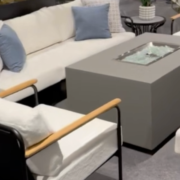At Taylor Creek in Green Bay, Wisconsin, success has come from a willingness to change — over and over again.
Mike Kapp, who co-owns the store with his mother and sister, says that his dad was working as a vice president of general merchandise with a grocery store and retail chain. That chain had begun a prototype of sorts, a specialty gift, floral and patio business store that switched to a Christmas shop during the holidays.
Then, when the parent company decided to concentrate on its core business instead, Kapp’s dad saw an opportunity to go out on his own and bought it.
Since then, the mix has changed, to include a much larger showroom — and a much broader product mix of patio furniture and outdoor furnishings including such things as grills and hammocks, along with gifts, toys and Christmas items.
For 2024, Kapp sees merchandising, product assortment and lead times as equally important priorities.

“I think it is always all of the above,” says Kapp. “The biggest thing is trying to maintain a level of quality and service. Reputation is huge. We are trying to stay away from what a big-box or internet provider has. A lot of what we sell is brick-and-mortar retail and we have systems in place for that to happen smoothly.”
He says that the reason to concentrate on in-person shopping rather than rolling out an online presence is that online is, frankly, more trouble than it is worth.
“Anything that is easily shipped and ready to go, somebody else is probably already doing it,” says Kapp. “Artificial floral, pictures, lamps, home furnishings and patio furniture — all that stuff is very difficult to ship.
Kapp says that the key is to deal only with vendors who agree to minimum advertised price policies, which are set up to allow retailers to make a decent profit.
“In all honesty, 70% of the stuff I open, I have to do something to it,” says Kapp. “I know how to fix it — if you are putting a fire pit table together and the jig was off and the holes are off, I can take a drill and ream it out or touch it up. If it’s the internet, they ship it to the customer and the customer pulls it out and there is something wrong — and they are going to say, ‘I shouldn’t have to do that.’ What does the internet seller do — sitting in an office in Chicago and shipping it from Florida or Alabama?”
Beyond competing with online, Kapp is also dealing with something of a slowdown in sales, which he sees as inevitable, given the market’s correction following Covid. Back then, sales were at record levels, lead times were impossible to estimate, delivery dates were pushed back and in some places in the casual furniture industry, everyone was in a panic. The relative calm of the marketplace today comes as a welcome development and as an opportunity for future planning
“You have to look forward,” says Kapp. “You have to have enough inventory but not too much. You have to set customers’ expectations. And you have to keep salespeople informed — that you have one set (of a particular selection) and it is shipping and you can do two weeks or six weeks out.
At least part of the challenge is the overall furniture industry, which has slashed the prices of indoor furniture and made it into something that is more or less disposable.
Then, when a customer sees an $8,000 or $10,000 price tag for outdoor, much higher than indoor, they have a case of sticker shock, even though the outdoor will last much longer and therefore won’t have to be replaced nearly as often.
Kapp said the key to overcoming such reluctance is often to figure out how the customer is going to use the furniture. Sometimes, for example, the customer is stuck on the idea of having a table with four chairs, even though that’s not what’s needed.
“You have to ask, how are YOU going to use this furniture on a daily basis?” asks Kapp. “Is it you and the kids or you and your wife and you have company over? It takes some talking to get them to wrap their head around the fact that they need four great chairs and a fire table. So often, you get the customer reiteration of the patio they knew when their kids were 10 but now, they are thirtysomething and have kids of their own. With grandkids, you want somewhere to sit and relax and watch them — you’re not going to eat outside.”
Beyond marketing and sales, Kapp says that Taylor Creek puts a lot of emphasis on what products to carry, in part by choosing those who have been in business for a long time, ship promptly and stand behind their products — and in choosing those who have excellent sales reps.
“Patio furniture is a niche,” says Kapp. “Anybody who has a new or great product had better have an ‘A’ sales guy because you are not going to get it in front of anyone if you don’t. Who trusts you as their customer? What is their shipping like? What are their requirements? What are their discounts? You need to have that rep who is in your corner and makes your life easier.”
To make the sale, Kapp depends on direct mail for his rewards program, which goes way beyond patio furniture to include the other things in his store, including upholstered furniture, clothing and home furnishings. He also markets through Facebook ads and other targeted media, preferring to concentrate primarily on his customers, who are ages 40 to 65.
“I don’t need 18-year-olds watching my ads because it’s not doing any good,” says Kapp. “You need to figure out who your customer is and get out in front of them.”
He said that his challenge is that his competition isn’t anything like him.
“We don’t have other stores like what we do,” says Kapp. “Being kind of the only show in town makes me fight against big boxes, the internet, the closest store 30 miles away or the furniture stores still carrying patio. Patio is not easy, like indoor furniture. There are different things — cushions and slings — it is a lot for a new salesperson. Indoor furniture is on commission and selling a patio set takes more effort than selling a Tempur-Pedic mattress because there are so many choices.”
Any advice for struggling casual retailers?
“Get a new job,” says Kapp. “But the biggest thing I’ve always done is to do things bigger than you are, in systems and in such things as gift cards. I buy nice gift cards like big stores have. Have your receipts, your advertising, your marketing all consistent, as though you are a 20-store chain. Make the store clean and make it look good — subconsciously, they notice if the floor is dirty. Make sure the bathroom is clean. Go after your demographic and build up loyal customers — those are all keys to running a business.”








